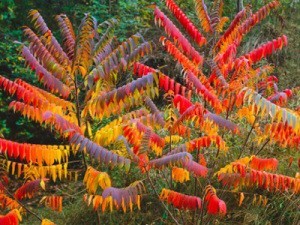 Sumacs are fast growing, tough, and versatile. They are often ignored in the home landscape, partially because many people assume they are poisonous, and partially because they are so common in the wild that they are simply overlooked.
Sumacs are fast growing, tough, and versatile. They are often ignored in the home landscape, partially because many people assume they are poisonous, and partially because they are so common in the wild that they are simply overlooked.
Sumacs spread by way of underground rhizomes and can take over small areas rapidly. They are not usually a good choice for people with small gardens, but if you have the space, there are plenty of advantages to growing them.
New plants are produced and spread rapidly via underground rhizomes. Their ability to colonize quickly has made them useful for soil erosion projects in some areas, and gotten them listed as invasive species in others.
Every autumn, without fail and regardless of weather conditions, the sumac's green, fern-like leaves turn attractive shades of yellow, orange, and red. Few trees and shrubs exists that can equal their stunning show of color. In the winter, sumac's scarlet, velvety clusters of fruit, and smooth, crooked branches draw in neighboring birds and bring visual appeal to an otherwise stark landscape.
Landscaping: Use it to prevent soil erosion along slopes, streams and near ponds. It can also be grown as a windbreak, to create shade, or to cover bare areas where no other plants will seem to grown. Since the plants are resistant to salt, they are good solutions along shorelines and roads.
Wildlife: In the winter, sumacs will be appreciated by the birds. The berries are a preferred food source for ruffed grouse, ring-necked pheasant, eastern phoebe, common crow, northern mockingbird, gray catbird, American robin, wood thrush, hermit thrush, eastern bluebird and European starling. Although not preferred, since the fruit clusters hang from the branches all winter, it is also used as a "last resort" food by over 30 other species when little else is available. The green flowers in spring may seem insignificant to us, but are attractive to Honeybees.
Other popular ornamental varieties include:Shining Sumac (Rhus colallina), Smooth Sumac (Rhus glabra), and Fragrant Sumac (Rhus aromatica).
Young plants can be raised in a nursery bed for the first year or two before moving them to their permanent home. Cuttings can also be made in the late fall, from roots or stems. Although possible, it's very difficult to grow sumac from seed. The seed coat is very hard and even in the wild, can take years to break down.
You'll find them growing near swamps, bogs, and other low-lying areas, exactly the opposite of where you would expect to find non-poisonous species growing (slopes and dry, sandy soil).
My aunt and uncle had sumac growing along one side of their house, it was there when they bought the house. When we cut the grass we would just cut right up to the bottom edge of the sumac to keep it under control. It also wasn't in full sun, a good portion of their yard was shady because there were lots of large trees.
Sumac is abundant here in Iowa. You see it along the ditches. It is so vibrant in the fall. I often wondered if you can successfully dry it. Does anyone know?
Advice to the wise just keep them from the foundation of the house or you will have a costly bill to get rid of it and to fix the foundation. I have seen this happen to several people. Sorry but I cannot share the love of sumac. It is pretty in the fall as long as it is out in the wild.
Dried ground Sumac (the fuzzy red cones of fruit) is used in lots of Mediterranean recipes. Fatoosh salad is one of my favorites and sumac is in the dressing, where it lends a really nice lemony flavor. I understand people use it for a version of lemonade, though I've never tried that yet myself.